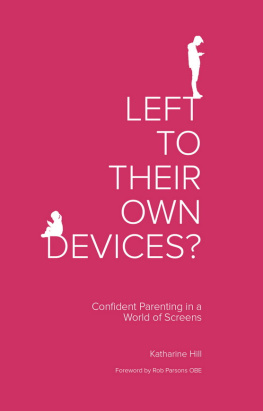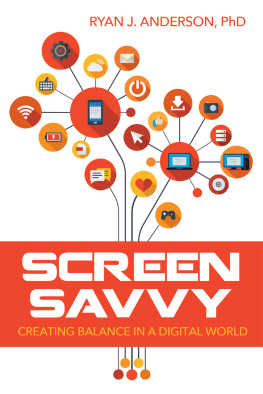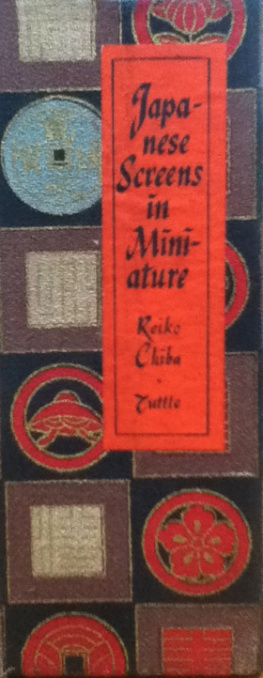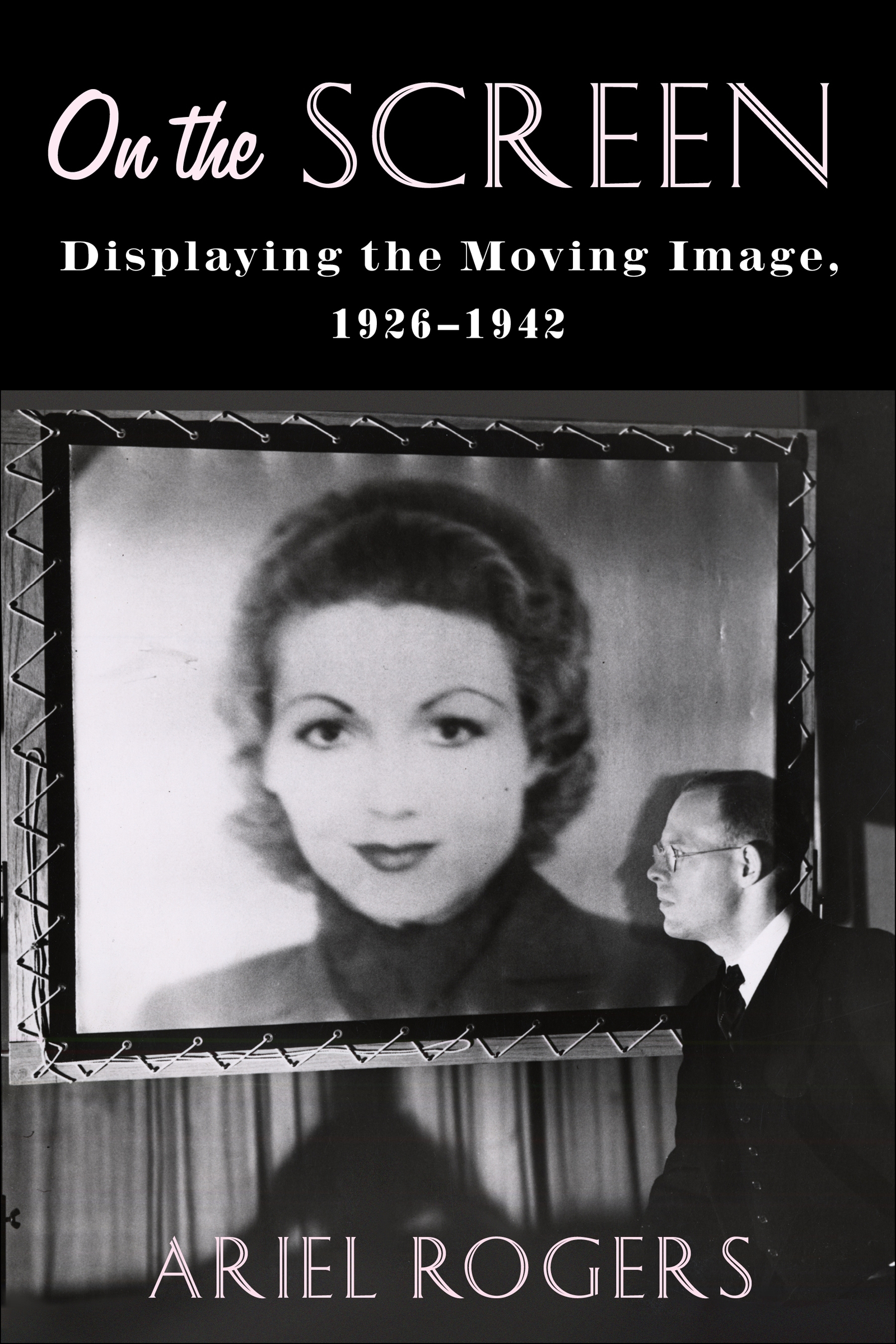Contents
Guide
Pagebreaks of the print version
ON THE SCREEN
FILM AND CULTURE SERIES
FILM AND CULTURE
Edited by John Belton
A series of Columbia University Press
For a complete list of titles, see .
ON THE SCREEN
Displaying the Moving Image, 19261942
ARIEL ROGERS
Columbia University Press
New York

Columbia University Press
Publishers Since 1893
New York Chichester, West Sussex
cup.columbia.edu
Copyright 2019 Columbia University Press
All rights reserved
E-ISBN 978-0-231-54803-8
Library of Congress Cataloging-in-Publication Data
Names: Rogers, Ariel, author.
Title: On the screen : displaying the moving image, 19261942 / Ariel Rogers.
Description: New York : Columbia University Press, [2019] | Series: Film and culture | Includes bibliographical references and index.
Identifiers: LCCN 2018058579 (print) | LCCN 2019004423 (ebook) | ISBN 9780231548038 (e-book) | ISBN 9780231188845 | ISBN 9780231188845 (cloth : alk. paper) | ISBN 9780231188852 (paperback : paper)
Subjects: LCSH: Motion picturesUnited StatesHistory20th century. | Motion picture industryTechnological innovations.
Classification: LCC PN1993.5.U6 (ebook) | LCC PN1993.5.U6 R6 2019 (print) | DDC 791.430973dc23
LC record available at https://lccn.loc.gov/2018058579
A Columbia University Press E-book.
CUP would be pleased to hear about your reading experience with this e-book at .
Cover design: Guerrilla Design
Cover image: George H. Clark Radioana Collection, Archives Center, National Museum of American History, Smithsonian Institution
CONTENTS
I n the process of writing this book, I have been buoyed by the inspiration, advice, encouragement, and various forms of support, both large and small, that I have received from many sides. John Belton has been providing me guidance, offering feedback on my writing, and sharing his own archival materials with regularity and incredible generosity since I was a graduate student. Francesco Casetti and two anonymous readers for Columbia University Press offered invaluable feedback on the manuscript, which helped to strengthen it considerably. Sarah Keller and Katharina Loew also read the entire manuscript, some parts more than once, with unflagging intelligence, care, and good humor. Doron Galili, Carter Moulton, Theresa Scandiffio, Lynn Spigel, Charles Tepperman, and Julie Turnock provided crucial feedback on sections.
My work was assisted by an ACLS Fellowship from the American Council of Learned Societies, which provided a valuable year of research leave. I am also grateful to Dean Barbara OKeefe of the Northwestern University School of Communication and David Tolchinsky in the Department of Radio, Television, and Film at Northwestern for offering the time and resources that made the writing of the book possible. In addition, I thank Wendy Wall and Tom Burke of the Alice Kaplan Institute for the Humanities at Northwestern for supplying subvention funds. I began this project while at the University of Southern Maine, where a Faculty Senate Research Grant permitted me to begin my research.
My colleagues in the Screen Cultures program at NorthwesternScott Curtis, Hamid Naficy, Miriam Petty, Jeffrey Sconce, Jacob Smith, Lynn Spigel, Neil Verma, and Mimi Whitehave contributed to this project in many ways, not least through their own scholarship. I am also grateful for the conversation and camaraderie of many other colleagues, including Thomas Bradshaw, Aymar Jean Christian, Nick Davis, Zayd Dohrn, Dilip Gaonkar, Rebecca Gilman, Kyle Henry, James Hodge, Anna Parkinson, Spencer Parsons, Eric Patrick, Dassia Posner, Ozge Samanci, Freda Love Smith, Shayna Silverstein, Liz Son, Debra Tolchinsky, Domietta Torlasco, and Harvey Young. Beyond Northwestern, I have benefitted from discussions, exchanges, and collaborations with Dudley Andrew, Robert Bird, James Chandler, Michael DeAngelis, Tiago de Luca, Zo Druick, Allyson Field, Oliver Gaycken, Bernard Geoghegan, Tom Gunning, Erkki Huhtamo, James Lastra, Laura Lee, Diane Wei Lewis, Joshua Malitsky, Caitlin McGrath, Ross Melnick, Daniel Morgan, Jennifer Peterson, Dana Polan, Jennifer Porst, Michelle Puetz, D. N. Rodowick, Zoran Samardzija, Salom Skvirsky, Jacqueline Stewart, Haidee Wasson, Kristen Whissel, Jennifer Wild, Pamela Wojcik, and Steve Wurtzler.
I have had the opportunity to present portions of my research at Northwestern University, Yale University, and Princeton University as well as at the Society for Cinema and Media Studies Conference, Screen Studies Conference, Modernist Studies Association Conference, Society for the History of Technology Conference, Console-ing Passions Conference, Visible Evidence Conference, and Ends of Cinema Conference at the Center for 21st Century Studies, University of WisconsinMilwaukee. The discussion and feedback provided by copanelists and members of the audience in these contexts contributed greatly to what has become this book.
For help with research, I thank Ellen Keith and Lesley Martin at the Chicago History Museum Research Center; Jenny Romero, Bob Dickson, Louise Hilton, and Kristine Krueger at the Margaret Herrick Library of the Academy of Motion Picture Arts and Sciences; Brett Service at the Warner Bros. Archives; Mark Quigley at the University of California at Los Angeles Film and Television Archive; Cassie Blake at the Academy Film Archive; Ashley Swinnerton at the Museum of Modern Art Film Study Center; Rebecca Poulson at the Northwestern University Device Lab; Patrick Seymour at the Theatre Historical Society of America Archives; Escott Norton at the Los Angeles Historic Theatre Foundation; Edward Baney at the Los Angeles Theatre; and the staffs at the National Museum of American History Archives Center, the Paley Center for Media, the University of California at Los Angeles Libraries Special Collections, the Columbia University Rare Book and Manuscript Library, the Columbia University Avery Architectural and Fine Arts Library, the Billy Rose Theatre Division of the New York Public Library for the Performing Arts, and the Library of Congress Manuscript Reading Room. For images and permissions, I thank Roni Lubliner of NBCUniversal; Betty Uyeda at the Natural History Museum of Los Angeles County; Steve Wilson at the Harry Ransom Center, University of Texas at Austin; Buddy Weiss at Photofest; Jennifer Willis at Crytek GmbH; and Joan Adria DAmico, executor of the Mary and Alfred Crimi estate.
It has been a pleasure working with Philip Leventhal, senior editor at Columbia University Press, who has been guiding the development of this project with both patience and persistence for several years. I also thank Michael Haskell and Monique Briones at Columbia for their work on the project and Annie Barva for her meticulous editing of the manuscript. The book has benefited in addition from the excellent research assistance of Crystal Camargo, Ian Hartman, Lauren Herold, and Carter Moulton.
Versions of parts of the book will appear or previously appeared as Screen Practices and Hollywood Cinema in the 1930s, Screen 60, no. 2 (Summer 2019); Taking the Plunge: The New Immersive Screens, in The Excessive Screen: Optical Media, Environmental Genealogies , edited by Rdiger Campe, Francesco Casetti, and Craig Buckley (Amsterdam: Amsterdam University Press, 2019); Die Konstruktion eines synchronen Feldes: Benjamin Schlangers Experimente mit der Gestaltung von Leinwnden und Kinoslen in den 1930er Jahren, translated by Guido Kirsten, Montage AV 25, no. 2 (2016): 16780; and Classical Hollywood, 19281946: Special/Visual Effects, in Editing and Special/Visual Effects , edited by Kristen Whissel and Charlie Keil (New Brunswick, NJ: Rutgers University Press, 2016), 6877. I am grateful for feedback from the reviewers and editors on these publications, which has also strengthened my work here.









